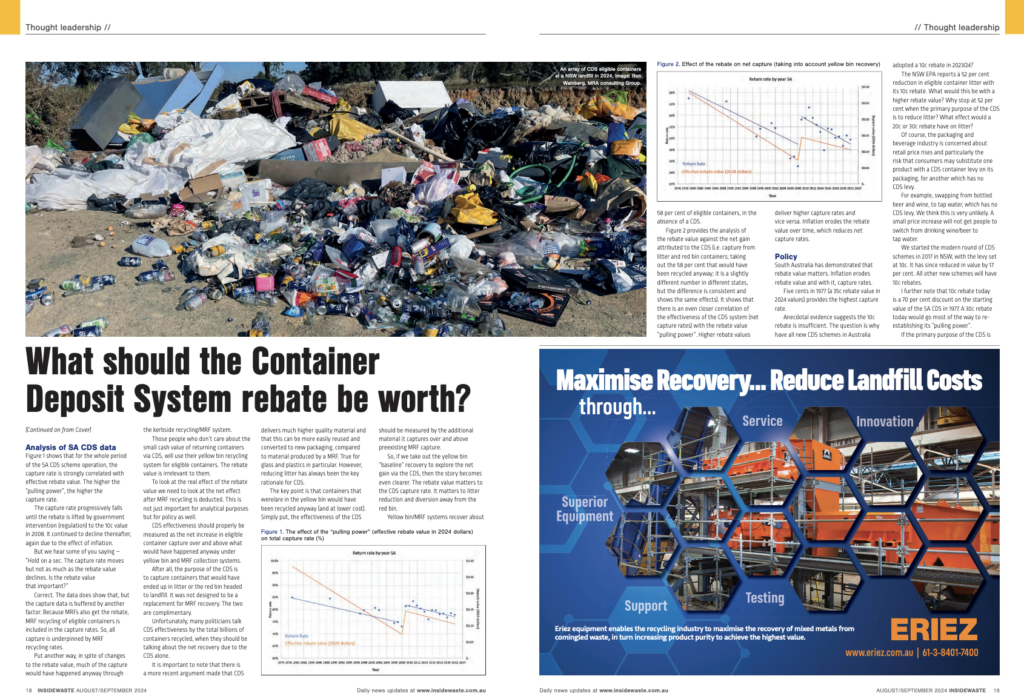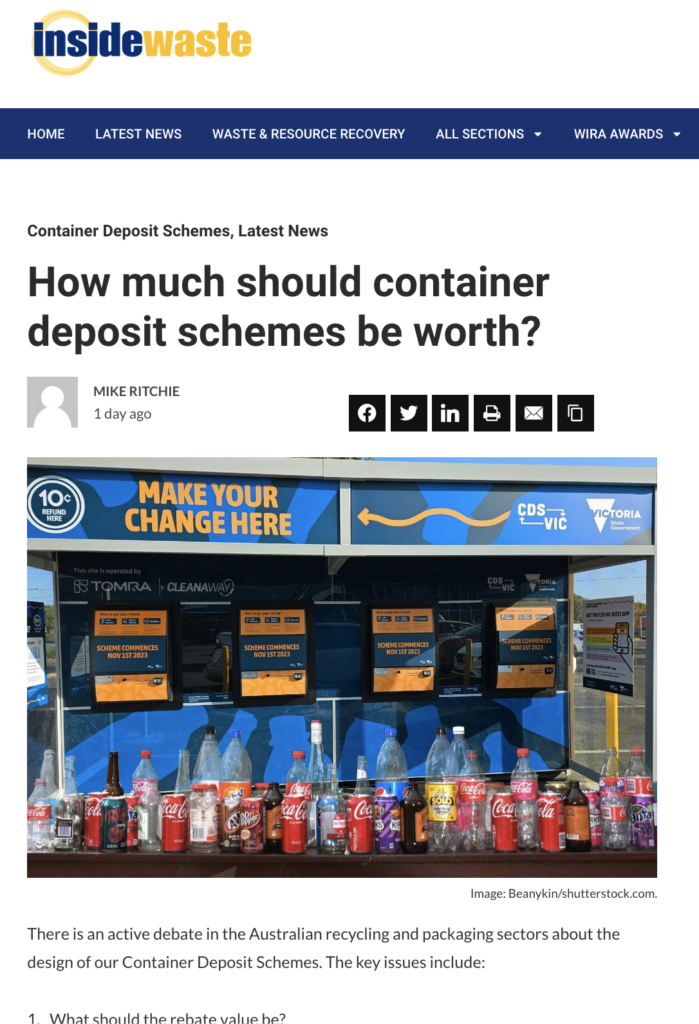What should the Container Deposit System rebate be worth?
By: Mike Ritchie and Conor Mackenzie, MRA Consulting Group
There is an active debate in the Australian recycling and packaging sectors about the design of our Container Deposit Schemes.
The key issues afoot include:
- What should the rebate value be?
- Should the schemes include wine and spirit bottles (glass) like QLD has just announced and/or milk containers like the NT has announced.
With the introduction of the Victorian and Tasmanian schemes we will for the first time have a national container collection arrangement.
We want to talk to the rebate value in this article. What is the right value for the rebate? It is currently 10 cents.
History
South Australia introduced their CDS scheme in 1977. It has run continuously ever since. It started with a 5c bottle return rebate which was then increased to 10c in September 2008.
When it was introduced, the value of 5c in 1977 was about 35c today (2024) based on RBA inflation rates.
Of course, given it was a fixed 5 cents, its value to the person returning a bottle decreased each year due to inflation. Think of the effective rebate value as the “pulling power” or gravitational pull, of the rebate.
The “pulling power” decreases over time due to inflation, until it is lifted again by regulation.
So, if we plot the effective rebate value in 2024 values, against the capture rate of eligible containers, we can see what sort of impact the value of the rebate has on people’s behaviour.
Analysis of SA CDS data
Figure 1 shows that for the whole period of the SA CDS scheme operation, the capture rate is strongly correlated with effective rebate value. The higher the “pulling power”, the higher the capture rate[1].
The capture rate progressively falls until the rebate is lifted by government intervention (regulation) to the 10c value in 2008. It continued to decline thereafter, again due to the effect of inflation.
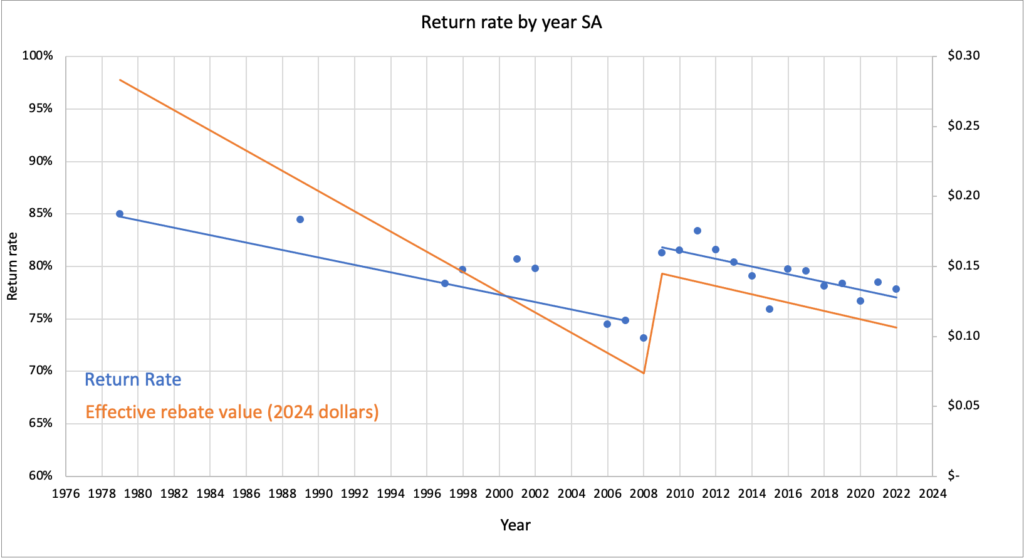
But we hear some of you saying – “Hold on a sec. The capture rate moves but not as much as the rebate value declines. Is the rebate value that important?”
Correct. The data does show that, but the capture data is buffered by another factor.
Because MRF’s also get the rebate, MRF recycling of eligible containers is included in the capture rates. So, all capture is underpinned by MRF recycling rates.
Put another way, in spite of changes to the rebate value, much of the capture would have happened anyway through the Kerbside recycling/MRF system.
Those people who don’t care about the small cash value of returning containers via CDS, will use their yellow bin recycling system for eligible containers. The rebate value is irrelevant to them.
To look at the real effect of the rebate value we need to look at the net effect after MRF recycling is deducted.
This is not just important for analytical purposes but for policy as well.
CDS effectiveness should properly be measured as the net increase in eligible container capture OVER and ABOVE what would have happened anyway under yellow bin and MRF collection systems.
After all, the purpose of the CDS is to capture containers that would have ended up in litter or the red bin headed to landfill. It was not designed to be a replacement for MRF recovery. The two are complimentary.
(Unfortunately, many politicians talk CDS effectiveness by the total billions of containers recycled, when they should be talking about the net recovery due to the CDS alone).
(Note: There is a more recent argument made that CDS delivers much higher quality material and that this can be more easily reused and converted to new packaging, compared to material produced by a MRF. True for glass and plastics in particular. However, reducing litter has always been the key rationale for CDS).
The key point is, that containers that were/are in the yellow bin would have been recycled anyway (and at lower cost). Simply put, the effectiveness of the CDS should be measured by the additional material it captures over and above preexisting MRF capture.
So, if we take out the yellow bin “baseline” recovery to explore the net gain via the CDS, then the story becomes even clearer. The rebate value matters to the CDS capture rate.
It matters to litter reduction and diversion away from the red bin.
Yellow bin/MRF systems recover about 58% of eligible containers, in the absence of a CDS[2].
Figure 2 provides the analysis of the rebate value against the net gain attributed to the CDS (i.e. capture from litter and red bin containers; taking out the 58% that would have been recycled anyway; it is a slightly different number in different States, but the difference is consistent and shows the same effects). It shows that there is an even closer correlation of the effectiveness of the CDS system (net capture rates) with the rebate value “pulling power”. Higher rebate values deliver higher capture rates and vice versa. Inflation erodes the rebate value over time which reduces net capture rates.
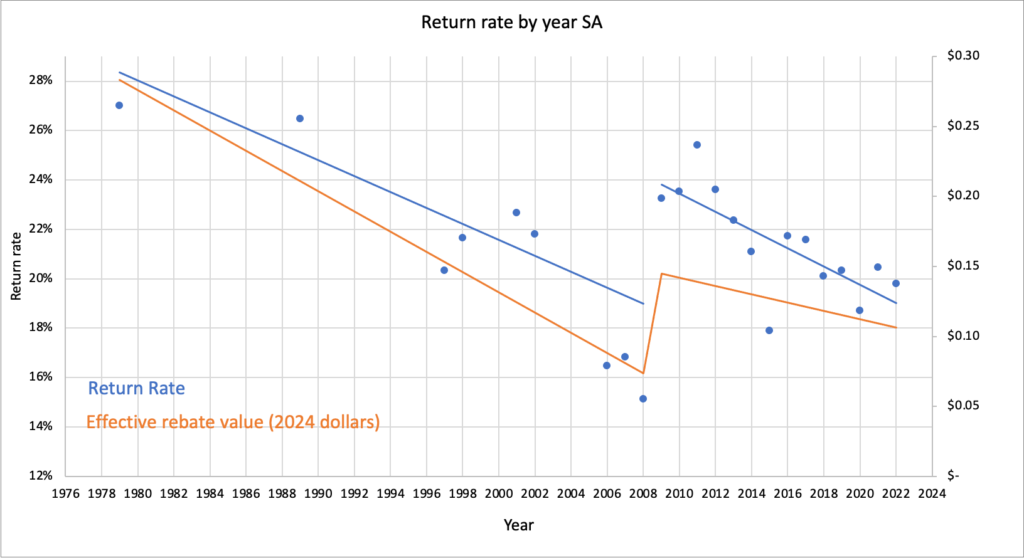
Policy
South Australia has demonstrated that rebate value matters. Inflation erodes rebate value and with it, capture rates.
Five (5) cents in 1977 (a 35c rebate value in 2024 values) provides the highest capture rate.
The photo below was taken at a NSW landfill in 2024! Evidently, the 10c rebate is insufficient. So, the question is why have all new CDS schemes in Australia adopted a 10c rebate in 2023/24?
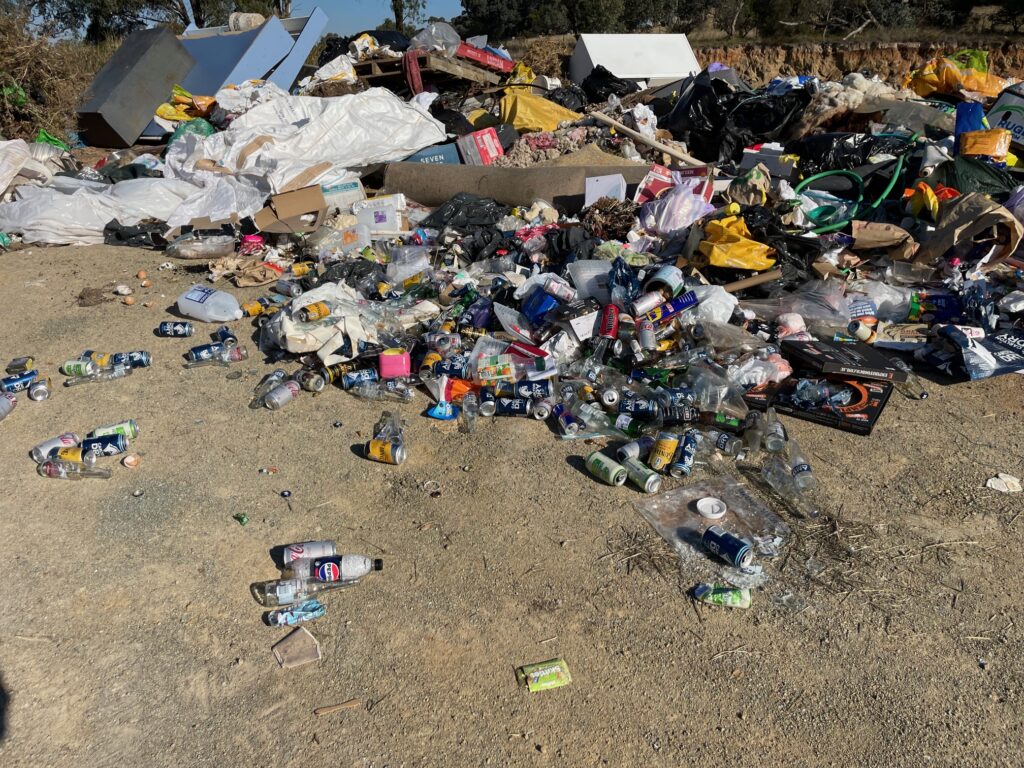
The NSW EPA reports a 52% reduction in eligible container litter with its 10c rebate. What would this be with a higher rebate value? Why stop at 52% when the primary purpose of the CDS is to reduce litter?
What effect would a 20c or 30c rebate have on litter?
Of course, the packaging and beverage industry is concerned about retail price rises and particularly the risk that consumers may substitute one product with a CDS container levy on its packaging, for another which has no CDS levy.
For example, swapping from bottled beer and wine, to tap water (which has no CDS levy). I think this is very unlikely. (And not in my world! A small price increase will not get people to switch from drinking wine/beer to tap water).
We started the modern round of CDS schemes in 2017 in NSW, with the levy set at 10c. (It has reduced in value by 17% since then). All other new schemes will have 10c rebates.
I further note that 10c rebate today is a 70% discount on the starting value of the SA CDS in 1977. A 30c rebate today would go most of the way to re-establishing its “pulling power”.
If the primary purpose of the CDS is to reduce litter, then 10c is achieving half of the goal (for example 52% litter reduction in NSW).
Tweet
A compromise position would be an immediate increase of all schemes to 20c with a “watch and wait” policy to assess the effect on net capture rate and particularly on litter reduction. Our economy has already borne the extra costs of the CDS collection system, so we should be working the system (capital) as much as possible. That means pushing the capture rate of eligible containers in litter and red bins as high as possible. That means, at the very least, adjusting the rebates to keep up with inflation.
[1] Sources: Container Deposit Scheme; EPA SA, Independent Review of Container Deposit Legislation in NSW; UTS, Industry Commission into Recycling 1991 Volume II, CDL in South Australia: Overview and Achievements; Boomerang Alliance.
[2] Source: ACT Container Deposit Scheme Regulations; Austlii
.
Mike Ritchie is the Managing Director and Conor Mackenzie is an intern at MRA Consulting Group.
This article has been published by the following media outlets:
